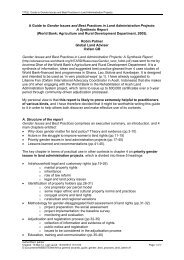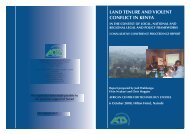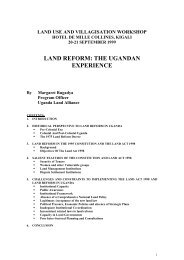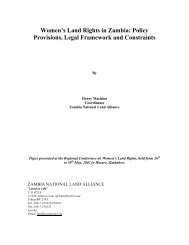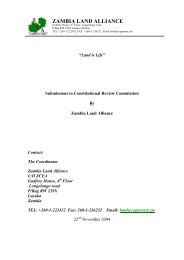Download - Mokoro
Download - Mokoro
Download - Mokoro
- No tags were found...
Create successful ePaper yourself
Turn your PDF publications into a flip-book with our unique Google optimized e-Paper software.
20support more livelihoods and therefore have a beneficial impact on the district’seconomy. ABP allows planning for land uses, and therefore for the identification of landfor redistribution, beyond project level, and thus has the potential to drive greater clarityon the kind of restructuring that is needed. However, the key limitation of ABP is that it isnot taking place within the context of national land use priorities. Area-based planningpresupposes that land needs can be met internally, at a local level, within the confines ofmunicipal or district boundaries. The limitations of this approach are: It presupposes that there can be a neat fit between identified needs and availablenatural resources within a given area;It allows only limited restructuring between communal and commercial areas;It also provides no guide for prioritisation of land uses, tenure types, or who is tobenefit.While ABP holds the potential for targeted interventions from government, rather thanthe ad hoc processes of the past, and to devolve integrated planning to the local level,its decentralised approach is also its weakness. To provide new directions and coherentalternatives for land use, ABP needs to be undertaken within a wider vision for agrarianrestructuring, and this must be provided at a national level.Project levelUp until the introduction of ABP, land use planning has taken place only at project levelin South Africa’s land reform, and has been guided by business plans developed foreach project. Although applicants may prepare a plan themselves, the guidelines forbusiness plans suggest that this option will seldom be feasible, and that applicants willrequire the assistance of a consultant, to whom the DLA will pay a fee. In the WesternCape, the guidelines run to eleven pages in point form, indicating the topics to becovered in a business plan (DLA 2006). Business plans, developed by privateconsultants appointed by the departments of Land Affairs, Agriculture or lendinginstitutions, have been guided by terms of reference, whose requirements differ acrossthe provinces. So nationally, there is no standard set of questions to which businessplans must respond. There is also no clear differentiation in the business planningrequirements between different kinds of projects. This means that the planningrequirements for projects for land access for household production are the same asthose involving commercial enterprises with strategic partners.Business plans involve consideration not only of the agricultural potential (ie. what is theland good for?) but also for the production environment (ie. what kinds of enterprises willwork, given markets, skill, asset & capital?). Land use planning within these businessplans is informed by assessments of technical feasibility, based on topography, soiltypes, rainfall and water availability, among others, premised on certain types ofproduction. Cash-flow projections informing business plans rely on “commercial budgets”for farming, periodically published as COMBUD by the Department of Agriculture. Thepotential income from a given crop can be read off from the COMBUD, which combinesexpected output for a certain type of farming, varied by region, and expected prices perunit of output.A review of business plans, undertaken for this paper, shows that these include basicdemographic information on project participants, but not a socio-economic analysis ofPolicy Options for Land and Agrarian ReformProgramme for Land and Agrarian Studies, University of the Western Cape




